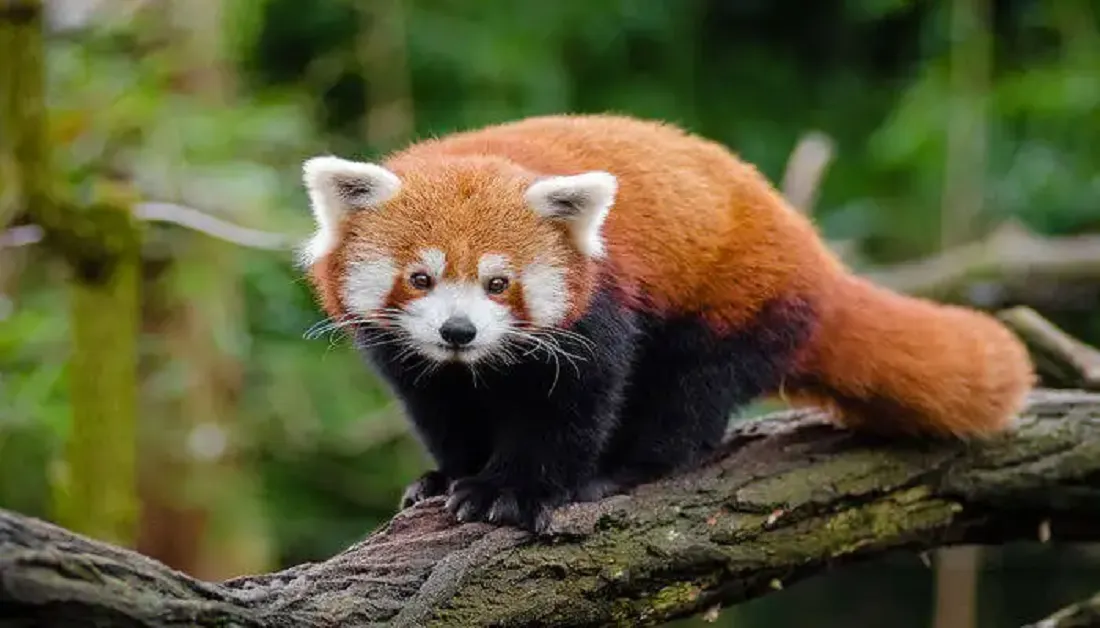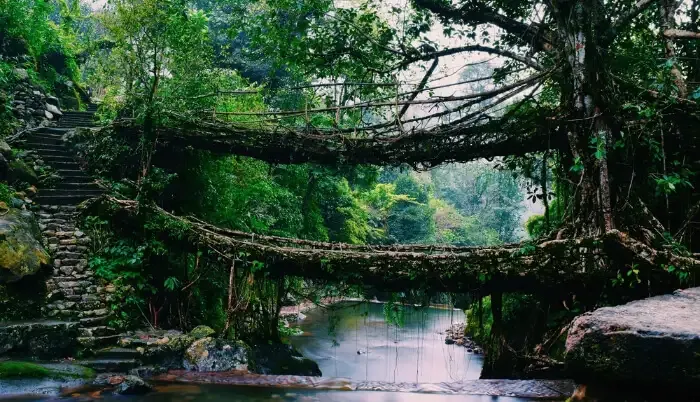5 Amazing Wildlife Sanctuary in Meghalaya

Table of Contents
ToggleMeghalaya Wildlife Sanctuary :
Tucked away in the enchanting Northeastern part of India, Meghalaya is a land of mystique and natural splendor. While its iconic living root bridges and misty landscapes have long captivated travelers, a lesser-known facet of Meghalaya beckons the adventurous spirit – its wildlife sanctuaries.
In this blog, we embark on a journey to unveil the lesser-explored treasures of Meghalaya’s wilderness. These sanctuaries, often hidden in the folds of its emerald hills, are nature’s sanctums, where untamed beauty thrives amidst dense forests and tranquil meadows.
Join us as we traverse the verdant realms of Meghalaya’s wildlife sanctuaries, where the call of the wild echoes through ancient trees, and rare species find refuge. These sanctuaries offer a glimpse into a world where Hoolock gibbons swing through the canopies, and vibrant orchids bloom in abundance.
Wildlife Sanctuary of Meghalaya :
1- Nokrek National Park and Biosphere Reserve
Here is the information about the Nokrek National Park and Biosphere Reserve in a different pattern:
- Location: The Nokrek National Park and Biosphere Reserve is located in East Garo Hills district, Meghalaya, India.
- Area: The Nokrek National Park is spread over an area of 47.48 square kilometers. The Nokrek Biosphere Reserve encompasses the Nokrek National Park and other areas of natural importance. The total area of the biosphere reserve is 820 square kilometers.
- Establishment: The Nokrek National Park was declared a national park in 1986. The Nokrek Biosphere Reserve was declared in 2009.
- Main attractions: The Nokrek National Park and Biosphere Reserve is home to a variety of wildlife, including the red panda, clouded leopard, Asian elephant, and gaur. The park is also home to a variety of plant species, including trees, shrubs, and herbs.
- Best time to visit: The best time to visit the Nokrek National Park and Biosphere Reserve is during the dry season, from October to April. During this time, the animals are more active and easier to spot.
- Things to do: Visitors can enjoy activities such as hiking, camping, and bird watching in the Nokrek National Park and Biosphere Reserve.
- Challenges: The Nokrek National Park and Biosphere Reserve is facing some challenges, including deforestation, poaching, and climate change. The government of Meghalaya is taking steps to address these challenges, such as increasing patrolling in the park and raising awareness about wildlife conservation.
2- Siju Wildlife Sanctuary
Here is the information about Siju Wildlife Sanctuary in a different pattern:
- Location: Siju Wildlife Sanctuary is located in East Khasi Hills district, Meghalaya, India. It is situated near the town of Siju, 45 kilometers (28 mi) from Baghmara, the district headquarters
- Area: It is spread over an area of 59.9 square kilometers (23.1 sq mi).
- Establishment: It was notified as a wildlife sanctuary in 1979.
- Main attractions: Over 300 species of birds, including the Blyth’s kingfisher, great pied hornbill, and rufous-necked hornbill.
- Best time to visit: October to April.
- Things to do: Go on a jeep safari to see the wildlife, go bird watching, take a walk or hike through the forest, visit the Visitor Centre, which has a museum and an aquarium, learn about the history and ecology of the sanctuary.
The sanctuary is famous for its population of birds. It is a home for many rare and protected birds, such as the Grey Hornbill. Other animals in the sanctuary include Asian elephant, Indian gaur, sambar deer, barking deer, wild boar, leopard, and Indian grey hornbill.
The sanctuary is a popular destination for birdwatchers. The best time to visit the sanctuary is during the winter season, from October to April. During this time, the birds are more active and easier to spot.
3- Baghmara Pitcher Plant Sanctuary
Here is some information about the Baghmara Pitcher Plant Sanctuary.
- Location: Baghmara Pitcher Plant Sanctuary is located in South Garo Hills district, Meghalaya, India. It is situated near Baghmara, 112 km south of Tura.
- Area: It is spread over 1.19 square kilometers (2.9 sq mi).
- Establishment: It was notified as a wildlife sanctuary in July 2022.
- Main attractions: Nepenthes khasiana, locally known as “Me’mang-Koksi” or ghost basket.
- Best time to visit: October to April.
The sanctuary is known for its population of the endangered pitcher plant species Nepenthes khasiana. These plants are found in the wild only in Meghalaya. The pitcher plant is a carnivorous plant that traps insects and other small animals in its pitchers. The plant then digests the insects.
The sanctuary is also home to a variety of other wildlife, including:
- Mammals: Wild boar, barking deer, and Indian pangolin.
- Birds: Blyth’s kingfisher, great pied hornbill, and rufous-necked hornbill
- Reptiles: Indian cobra, python, and monitor lizard.
The sanctuary is a popular destination for tourists and researchers. The best time to visit the sanctuary is during the dry season, from October to April. During this time, the plants are more active and easier to spot.
4- Balpakram National Park
Here is the information about Balpakram National Park in a different pattern:
- Location: Balpakram National Park is located in the South Garo Hills district of Meghalaya, India. It is situated near Baghmara, 170 km south of Tura.
- Area: It is spread over an area of 220 square kilometers (85 sq mi).
- Establishment: It was inaugurated in December 1987.
- Main attractions: Elephant, tigers, barking deer, gaur, clouded leopard, red panda, black bear, Blyth’s kingfisher, great pied hornbill, rufous-necked hornbill, and many others.
- Best time to visit: October to April.
- Things to do: Go on a jeep safari to see the wildlife, go bird watching, take a walk or hike through the forest, visit the Visitor Centre, learn about the history and ecology of the park.
The park is famous for its forest-covered canyon-cum-gorge, which is now part of a National Park. It is also known for its population of the endangered red panda.
5- Simsang Wildlife Sanctuary
Here is some information about the Simsang Wildlife Sanctuary.
- Location: Simsang Wildlife Sanctuary is located in the East Khasi Hills district of Meghalaya, India. It is situated near Jowai, 45 kilometers (28 mi) from Shillong.
- Area: It is spread over 5.18 square kilometers (2.07 sq mi).
- Establishment: It was notified as a wildlife sanctuary in 1979.
- Main attractions: The sanctuary is home to a variety of wildlife, including:
- Mammals:Elephant, tiger, gaur, sambar deer, barking deer, wild boar, leopard, and Indian grey hornbill.
- Birds:Blyth’s kingfisher, great pied hornbill, rufous-necked hornbill, and many others.
- Reptiles:Indian cobra, python, and monitor lizard.
- Amphibians:Indian tree frog, Indian bullfrog, and Indian night frog.
- Best time to visit:October to April.
- Things to do:Go on a jeep safari to see the wildlife, go bird watching, take a walk or hike through the forest, visit the Visitor Centre, learn about the history and ecology of the sanctuary.
The sanctuary is famous for its population of the endangered hoolock gibbon. It is also home to various other wildlife, including the tiger, elephant, and gaur.
Final Note:
As we conclude this remarkable journey, let us carry forward the spirit of conservation, the wonder of the wild, and the commitment to protect our planet’s natural wonders. Whether you’re inspired to plan your adventure amidst the lush jungles and serene meadows of Meghalaya or choose to support conservation efforts from afar, let the wild spirit of these sanctuaries stay alive within you.
In the heart of Meghalaya, where the forests whisper secrets, the rivers weave stories, and the call of the wild lingers, the wildlife sanctuaries stand as eternal reminders of the beauty and fragility of our planet’s ecosystems. They are not just sanctuaries; they are legacies, and their stories are etched in every bird’s song, every rustling leaf, and every heartbeat that echoes through their hallowed grounds.

